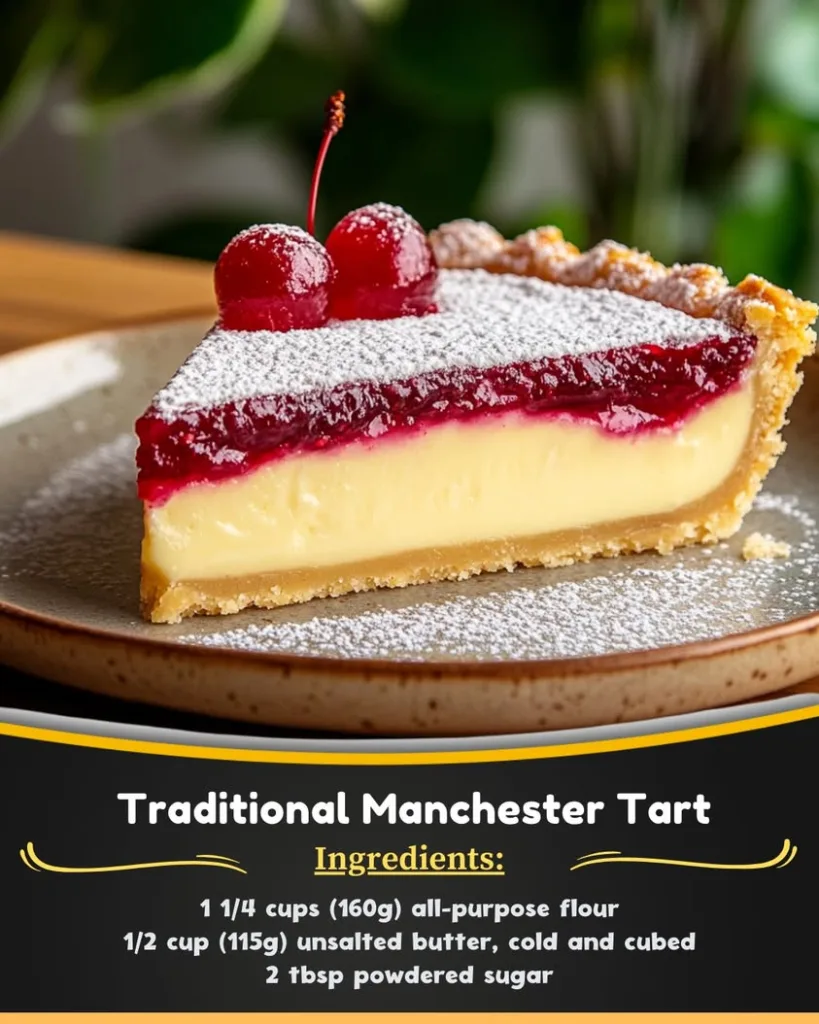Traditional Manchester Tart: A Classic British Delight
Manchester Tart is a wonderful homage to British baking, celebrating rich flavors and nostalgic memories. This tart features a buttery pastry crust filled with a layer of jam, a creamy custard, and is topped with a sprinkle of coconut. The combination of sweet and tangy flavors creates a delightful contrast that lingers on the palate with every bite. Perfect for afternoon tea or as a dessert after any meal, this classic recipe will take you on a journey back to simpler times.
The allure of Manchester Tart lies not just in its flavors but in its texture. The crispness of the pastry pairs beautifully with the velvety smooth custard, while the coconut on top adds a playful chewiness. Each element of this tart works together harmoniously, ensuring it is a treat to both the eyes and the taste buds. With a sprinkle of icing sugar for final touches, it becomes not only a dessert but a show-stopping centerpiece.
Quick Recipe Highlights
- Flavor Profile: The tart features a delightful blend of sweetness from the jam and coconut, complemented by the creamy custard.
- Texture: Expect a delightful crunch from the pastry, creaminess from the custard, and a chewy finish with the coconut topping.
- Aroma: The warm vanilla notes from the custard meld beautifully with the toasty coconut aroma.
- Visual Appeal: The bright yellow custard shines through the toasted coconut topping against the inviting golden pastry.
- Skill Level Needed: This recipe requires basic baking skills but offers an opportunity to enhance your pastry-making technique.
- Special Equipment: A tart tin is necessary for proper shaping and baking of the crust.
Recipe Overview
- Difficulty Level: This traditional Manchester Tart is rated as medium difficulty, making it suitable for those who are comfortable with basic baking techniques and assembly.
- Category: This tart falls under the dessert category, ideal for festive occasions, tea times, or a sweet ending to a meal.
- Cuisine: The Manchester Tart has roots in British culinary tradition, specifically attributed to the city of Manchester and its rich baking history.
- Cost: The ingredients for this recipe are relatively affordable, making it an accessible treat for gatherings on a budget.
- Season: Best enjoyed year-round, this tart can be particularly delightful during the spring and summer months when fresh fruits are available.
- Occasion: Perfect for birthday parties, family gatherings, or a cozy afternoon tea with friends.
Why You’ll Love This Recipe
This Traditional Manchester Tart is a treat for the senses, bringing along a mix of taste and texture that is simply irresistible. The balance of sweetness from the jam and the creaminess of the custard creates a delightful harmony that appeals to all ages. Each bite offers a refreshing experience, making it an excellent choice for both casual family meals and elegant dinner parties.
Convenience and preparation are also key advantages of this recipe. Most of the components can be prepared in advance, particularly the pastry and custard, allowing for easy assembly on the day of serving. This makes it a perfect option for busy hosts who still want to impress their guests with a stunning dessert.
In terms of nutritional benefits, the use of coconut adds a source of healthy fats that can be beneficial in moderation. Furthermore, this tart can be a source of happiness, with its vibrant flavors and colors, likely to brighten anyone’s day.
Socially, the Traditional Manchester Tart serves as a fantastic conversation starter at gatherings. The charm of a retro recipe is always appealing, allowing hosts to share its history and their personal touches with friends and family.
Lastly, the cost-effectiveness of this dessert cannot be overstated. Using simple ingredients often found in pantry staples, you can create a dessert that looks and tastes like it came from a high-end bakery, all while staying within budget.
Historical Background and Cultural Significance
The origins of the Manchester Tart trace back to the city of Manchester in England, where it became popular in the 19th century. Originally created by local bakers, it is believed to have been a response to the rise of patisserie culture, where desserts were becoming more elaborate and sought after by the bourgeois class.
Culturally, the Manchester Tart holds a special place in British gastronomy, cherished as a nostalgic treat that many grew up with. It represents a time when family recipes were passed down through generations, bringing back fond memories for many who indulge in it today.
The evolution of the recipe over the years has seen variations in ingredients and techniques. While the classic recipe remains beloved, modern adaptations have introduced different flavors and textures to cater to contemporary palates.
In various regions across the UK, you’ll find unique takes on the Manchester Tart, often incorporating local ingredients or cultural influences, showcasing the versatility and timelessness of this iconic dessert.
Ingredient Deep Dive
Pastry:
The foundation of any tart lies in its pastry, made primarily from flour, butter, and sugar. This simple yet essential ingredient has a long history, as it has been used in many forms of baking for centuries. Pastry provides a tender and flaky base, which is crucial for a well-constructed tart. For best results, use cold butter and handle the dough minimally to prevent toughness.
Custard:
The custard is the heart of the Manchester Tart. Traditionally made with eggs, milk, and sugar, this creamy layer adds richness and depth to the tart. Custard has cultural significance and is a staple in many British desserts. It is also packed with protein and vitamins, making it a nutritional powerhouse. Opt for fresh eggs and whole milk for the best flavor.
Coconut:
Topping the tart with desiccated coconut adds a lovely chew and a hint of tropical flavor. Coconut has gained popularity worldwide due to its unique taste and health benefits, such as promoting heart health. When choosing coconut, look for unsweetened varieties for better balance in desserts. Ensure it is stored in a cool, dry place to preserve its freshness.
Jam:
A layer of fruit jam, traditionally raspberry or strawberry, adds sweetness and a burst of fruit flavor. Jam has a rich history in preserving fruit and can be enjoyed in many forms. Use high-quality jam for the best flavor experience. Look for jams with minimal additives for a fresher taste.
Common Mistakes to Avoid
- Skipping the chill: Failing to chill the pastry before rolling can lead to shrinking during baking. Always let it rest in the fridge for at least 30 minutes.
- Overbaking the crust: Keep an eye on the baking time; overbaked pastry can turn dry and lose its delicious flakiness.
- Not using cold ingredients: Custard should be prepared with cold milk and eggs to achieve a smooth texture without curdling.
- Pouring custard too hot: Let the custard cool slightly before pouring it into the tart shell to prevent it from cooking the pastry.
- Neglecting to taste: Always taste your jam and custard before assembling to ensure the balance of flavors is perfect.
- Inadequate cooling time: Ensure the tart is completely cooled before serving; serving it warm can cause the custard to run.
- Ignoring the coconut: Toasting the coconut before adding as a topping can enhance its flavor significantly, so don’t skip this step.
- Improper storage: To prevent sogginess, store any leftover tart uncovered in the fridge for maximum freshness.
Essential Techniques
Making Pastry: The key to a good pastry is using cold butter and minimal handling of the dough. This prevents it from becoming tough. Roll out gently and use a light touch to ensure a flaky texture. Watch for visual cues: the dough should be pliable but not sticky.
Preparing Custard: Custard-making requires careful temperature control to avoid curdling. Whisk the eggs and sugar until light, gradually adding warmed milk. Using a double boiler can help with even cooking. Look for a thickened consistency, which will coat the back of a spoon.
Baking the Tart: Pre-bake the pastry to achieve a golden color and crisp texture. Ensure your baking weights are evenly distributed during the blind bake to prevent bubbling. Visual cues include a light golden color and firm texture without browning too much.
Pro Tips for Perfect Traditional Manchester Tart
1. Always chill your ingredients and dough before baking to get that perfect flaky crust.
2. Use high-quality vanilla for the custard to enhance the flavor profile.
3. Make the tart a day ahead; it tastes even better after resting in the fridge overnight.
4. Feel free to mix and match jams based on seasonal fruits available.
5. For a delightful twist, add a splash of almond extract to the custard.
6. Experiment with different toppings, such as toasted almonds or fresh berries.
7. Ensure the tart is completely cooled before serving to maintain texture and flavor.
8. When making the custard, stir continuously to prevent eggs from scrambling.
Variations and Adaptations
For regional variations, consider incorporating local jams or fruits that represent your area, such as blackcurrant or apricot. Seasonal adaptations could feature citrus-infused custards in winter or berry variations in summer, adjusting the jam based on what is available and delicious.
Dietary modifications can be made by substituting dairy in the custard with plant-based alternatives, like coconut or almond milk, and using dairy-free margarine for the pastry. For gluten-free adaptations, replace standard flour with a gluten-free blend, adjusting liquids as needed to maintain a desirable dough consistency.
Flavor variations are endless; adding spices such as nutmeg or cinnamon can enhance the custard. You can play with texture by incorporating layers of fresh fruit within the tart or varying the coconut toppings. If you’re looking for an eye-catching presentation, consider making mini tarts or tartlets for a modern take.
Serving and Presentation Guide
Achieving an elegant presentation for your Manchester Tart starts with clean, even slices adorned with a dusting of icing sugar. Serve on a decorative cake stand for an enticing look. Garnish with fresh mint leaves or additional toasted coconut on top to enhance visual appeal.
Consider serving with a dollop of lightly whipped cream or a scoop of vanilla ice cream alongside to embrace the creamy and luxurious textures. You could also pair it with fresh fruit such as raspberries or strawberries to brighten the plate.
Temperature considerations are key; this tart is best served chilled but can warm slightly at room temperature if preferred. Portion control can be managed by cutting the tart into equal slices, allowing guests to enjoy a satisfying dessert without overindulgence.
Wine and Beverage Pairing
When it comes to wine pairings, a light dessert wine like a Moscato or an off-dry Riesling complements the sweetness of the tart beautifully. For a richer experience, a late harvest wine could also work well, adding complexity to each sip.
For non-alcoholic alternatives, consider serving with sparkling water infused with lemon slices or a refreshing iced tea, both of which can cleanse the palate between bites.
Coffee or tea pairs wonderfully with the Manchester Tart, specifically a light-bodied black tea or a smooth espresso that can highlight the tart’s buttery flavors. Ensure to serve all beverages at the optimal temperature for the best experience.
Storage and Shelf Life
To ensure the freshness of your Traditional Manchester Tart, store it in the refrigerator, covered loosely with foil or parchment paper to prevent moisture buildup. Ideal temperature for storage is between 35°F to 40°F.
The tart should be consumed within 3-4 days for optimal flavor and texture. Signs of spoilage include an off smell or unusual texture changes in the custard.
If you plan to freeze the tart, do so before adding coconut topping and custard. Freeze tightly wrapped for up to 2 months. Thaw in the fridge overnight before completing the assembly.
Reheating should be avoided to retain texture; rather, serve cold or at room temperature for the best taste experience.
Make Ahead Strategies
Planning is key, and you can prepare the pastry up to 2 days in advance, storing it wrapped in plastic wrap in the fridge. The custard can also be made a day ahead and kept covered in the refrigerator until your tart is assembled.
For optimal quality, assemble your tart no more than a few hours before serving to maintain texture. If preparing for a big event, consider pre-baking the shell the day before and filling it with the custard and toppings on the day of.
If using traditional flavors, save the garnishing elements like coconut and fruits until just before serving to ensure they remain fresh and vibrant.
Scaling Instructions
When scaling this Traditional Manchester Tart recipe, halving the ingredient quantities is straightforward but ensure that you still use the same size tart tin to maintain proper proportions.
When doubling the recipe, you may need to adjust your baking time and it’s advisable to use two separate tart tins rather than trying to bake one larger tart, as even cooking is crucial for texture.
Timing modifications will be necessary when scaling; keep an eye on current baking times, as the tarts may require different durations based on thickness and pan size.
When considering storage for leftovers, ensure to use appropriately sized containers for optimal organization in your fridge or freezer.
Nutritional Deep Dive
Examining the macro breakdown of a slice of Manchester Tart reveals a balance of carbohydrates, fats, and proteins. The buttery pastry contributes to healthy fats, while the custard adds both protein and essential vitamins through eggs and milk.
Micronutrient analysis shows that the dish is rich in Vitamin D and calcium due to the dairy content. Though mostly a treat to enjoy, consider its nutritional aspects when fitting it into a balanced diet.
Health benefits include the use of eggs, which are a source of high-quality protein, while coconut offers fiber and healthy fats known for heart health.
Dietary considerations should be made for those with allergies; however, dietary adaptations can be utilized to make this tart more accessible to various health needs, including vegan or gluten-free modifications.
Portion analysis indicates that moderation is key, as indulging too often might lead to excessive calorie intake; balance it with fresh fruits or lighter meals throughout the day for a composed diet.
Dietary Adaptations
For gluten-free adaptations, substitute wheat flour with a blend of almond flour and gluten-free flour, ensuring a similar texture is achieved in the pastry.
Dairy-free versions can effortlessly replace cow’s milk and butter with oat milk and coconut oil, allowing those with lactose intolerance to enjoy this dessert without compromising on taste.
For those on a vegan diet, using plant-based custard made from almond milk and using flaxseed meal as an egg substitute yields a similar decadent result.
Low-carb dieters can experiment with almond flour crusts instead of traditional pastry, and using sugar alternatives in the custard mixture would keep it compliant with such dietary restrictions.
Keto enthusiasts may benefit from using erythritol or stevia to sweeten the custard and a nut-based crust, ensuring a higher fat content adheres to their dietary goals.
Low-FODMAP diets may require caution with jam choices, going for pure fruit spreads without added high-FODMAP ingredients to maintain balance.
Troubleshooting Guide
For texture issues, if the crust becomes too soggy, ensure thorough blind baking at the right temperature, and let it cool completely before adding custard. If custard is runny, check for proper cooking temperature and times as it should set while cooling.
In terms of flavor balance, if it tastes too sweet, consider balancing with a pinch of salt or acidity from lemon juice in the custard. If flavors are weak, increase the amount of vanilla or use fresh fruit for a punch.
Temperature problems during baking can often be resolved by placing the tart on the lower rack of the oven for even heat distribution.
Equipment challenges include improper sizes; ensure the tart tin used has shallow sides for even cooking.
If using alternative ingredients during substitutions, be mindful of the moisture content, as it may affect the dish’s overall success.
Timing concerns can lead to undercooking if not carefully monitored, so setting a timer helps keep everything consistent throughout the baking process.
Recipe Success Stories
Many home bakers have shared their successes with Traditional Manchester Tart, noting how it became a showstopper at family gatherings. The nostalgia tied to this recipe often sparks joyful conversations about family traditions and past baking adventures.
Variations from readers include a delightful banana-coconut mix, replacing traditional jam and showcasing personal creativity. Others have successfully shared tips on perfecting the custard, emphasizing the importance of patience and constant stirring.
Photographers share their stunning representations of the tart on social media, favoring its vibrant colors and beautiful presentation. The combination of satisfying texture and rich flavors makes it a favorite for culinary photographers.
Individuals have also suggested unique combinations with chocolate fillings or seasonal fruits, showing how this classic dessert can take on a new life.
Each success story adds to its charm, encouraging both novice and experienced bakers to give it a try, leaving behind their unique legacy with each tart.
Frequently Asked Questions
Yes, you can freeze the tart before adding the toppings. It can be frozen for up to two months, then fully thawed in the refrigerator prior to serving.
What’s the best jam to use?
Raspberry or strawberry are traditional choices, but feel free to experiment with your favorite flavors!
How do I know when the custard is set?
The custard should be thickened and should coat the back of a spoon without running.
Can I make the tart gluten-free?
Absolutely! Substitute regular flour with a gluten-free blend and ensure the other ingredients are gluten-free.
Is there a dairy-free version?
Yes! Use plant-based milk and dairy-free butter to create a dairy-free custard and pastry.
How long does the tart last in the fridge?
The tart can last up to 3-4 days in the refrigerator, if properly stored.
Can I use fresh fruit instead of jam?
Yes, using thinly sliced fresh fruits layered under the custard can create a refreshing alternative!
What is the best way to slice a tart?
Use a sharp knife run under hot water for cleaner cuts, ensuring each slice shows off the layers.
Can I add flavors to the custard?
Yes, you can add vanilla extract, lemon zest, or coconut extract for additional flavoring!
What if my tart crust is too thick?
If your crust is thicker than desired, it may take longer to bake. Adjust your baking time accordingly while checking for doneness.
Can I add nuts to the topping?
Certainly! Toasted almonds or walnuts can add crunch and complement the coconut flavor beautifully.
Is there a way to make it lower in sugar?
You can reduce the sugar in the custard and use a low-sugar jam to cater to dietary preferences.
Additional Resources
If you enjoy this Traditional Manchester Tart, you might find similar recipes on our blog, such as classic British Victoria Sponge or delightful Bakewell Tart.
Our technique guides take you through mastering pastry and custard making, ensuring you build confidence in your baking skills. Explore ingredient spotlights to learn more about coconut and its health benefits.
For the equipment needs, we recommend investing in quality tart tins and pastry cutters. Seasonal variations can greatly inspire your baking journey; adapt the tart for autumn by including spiced flavors or winter fruits.
Join the Conversation
We invite our community to share their own versions of the Traditional Manchester Tart! Join us on social media to post pictures of your creations, your baking successes, or any tips and tricks you’ve discovered along the way.
Engage with fellow bakers by leaving comments on our blog, sharing your experience, or any creative variations you’ve tried. Let’s create a supportive baking community where everyone can share joy and inspiration through delicious food!
The Recipe
Traditional Manchester Tart
Serves: 8
Prep Time: 30 mins
Cook Time: 45 mins
Total Time: 1 hr 15 mins
Kitchen Equipment Needed
- Tart tin
- Mixing bowls
- Whisk
- Rolling pin
- Measuring cups and spoons
Ingredients
- 180g plain flour
- 90g unsalted butter, chilled
- 45g icing sugar
- 1 large egg yolk
- 250ml milk
- 2 large eggs
- 90g caster sugar
- 1 tsp vanilla extract
- 200g raspberry jam
- 50g desiccated coconut
Directions
- Preheat your oven to 180°C (350°F).
- In a mixing bowl, combine flour, butter, and icing sugar until it resembles breadcrumbs. Add egg yolk and mix until it forms dough.
- Wrap the dough in plastic wrap and chill for 30 minutes.
- Roll out the pastry and fit it into the tart tin. Trim excess and blind bake for 15 minutes.
- For the custard, warm milk in a saucepan. In a bowl, whisk eggs and sugar together until light.
- Gradually add warm milk to the egg mixture to temper it, stirring constantly.
- Return the mixture to the pan, add vanilla, and cook gently until thickened. Pour into the baked pastry.
- Spread jam over the custard, and top with desiccated coconut.
- Bake for an additional 20-25 minutes until set and lightly golden.
- Let cool, then chill in the refrigerator before serving.
Recipe Notes
- For best results, use fresh and high-quality ingredients.
- Feel free to adjust the sweetness in the custard according to your taste.
- To make it more decadent, consider adding a layer of chocolate or nuts between the jam and custard.










